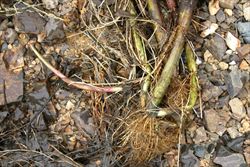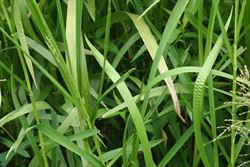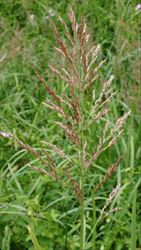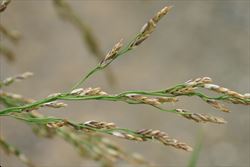Click on images to enlarge

infestation (Photo: Trevor James)

habit (Photo: Trevor James)

habit (Photo: Trevor James)

lower stems, roots, and rhizome (Photo: Trevor James)

upper stems and leaves (Photo: Trevor James)

close-up of ligule and base of leaf blade (Photo: Trevor James)

much-branched seed-head (Photo: Trevor James)

close-up of flower spikelets (Photo: Trevor James)

close-up of seeds (Photo: Jose Hernandez at USDA PLANTS Database)
Scientific Name
Glyceria maxima (Hartm.) Holmb.
Synonyms
Glyceria aquatica (L.) Wahlb.Molinia maxima Hartm.Panicularia aquatica (L.) KuntzePoa aquatica L.
Family
Gramineae (South Australia)Poaceae (Queensland, New South Wales, the ACT, Victoria, Tasmania, Western Australia and the Northern Territory)
Common Names
English water grass, English watergrass, glyceria, great mannagrass, reed canegrass, reed grass, reed mannagrass, reed meadow grass, reed sweet grass, reed sweet-grass, reed sweetgrass, tall glyceria, tall mannagrass, water meadow-grass, water meadowgrass
Origin
Native to most of Europe (i.e. Denmark, Finland, the UK, Ireland, Norway, Austria, Belgium, Czechoslovakia, Germany, Hungary, the Netherlands, Poland, Switzerland, Belarus, Estonia, Latvia, Lithuania, Moldova, western Russia, Ukraine, Bulgaria, Greece, Italy, Romania, Yugoslavia and France), Turkey and temperate Asia (i.e. central Russia and western Siberia).
Cultivation
This species was deliberately introduced as a ponded pasture plant for seasonally inundated pastures in southern Australia.
Naturalised Distribution
Widely naturalised in the wetter parts of south-eastern Australia (i.e. in New South Wales, Victoria and Tasmania) and occasionally naturalised in the coastal districts of south-western Western Australia. It has also been recorded in south-eastern South Australia and south-eastern Queensland in the past, but these records are more than 50 years old.
Naturalised overseas in New Zealand, north-eastern USA and Canada.
Habitat
A weed of wetlands, swamps, waterways, ponds, dams, lake margins, drains, irrigation channels, riparian areas and other moist sites in the temperate regions of Australia.
Habit
A large and long-lived (i.e. perennial), upright (i.e. erect), grass usually growing 1-2.5 m tall.
Distinguishing Features
-
a large and long-lived grass with upright flowering stems growing 1-2.5 m tall.
-
these flowering stems are hollow, hairless, and ribbed lengthwise.
-
it also spreads laterally via long creeping underground stems.
-
its large leaves (20-60 cm long and 7-20 mm wide) are flat with a prominent midvein.
-
its seed-head is an open panicle (12-45 cm long) bearing numerous small flower spikelets (5-12 mm long).
-
each flower spikelet has 3-10 tiny flowers, which separate from each other at maturity.
Stems and Leaves
The upright (i.e. erect) flowering stems (i.e. culms) are quite robust (up to to 12 mm thick) and hollow. These stems are ribbed lengthwise (i.e. longitudinally), hairless (i.e. glabrous) and sometimes have some small glands in a ring below each joint (i.e. node). This species also spreads laterally via long creeping underground stems (i.e. rhizomes).
The leaves consist of a leaf sheath, which encloses the stem, and a spreading leaf blade. The leaf sheath is hairless (i.e. glabrous) and also ribbed lengthwise (i.e. longitudinally). The leaf blade (20-60 cm long and 7-20 mm wide) is flat with a prominent midvein and a pointed tip (i.e. apiculate apex). It has entire margins and is hairless (i.e. glabrous), but is often somewhat rough to the touch (i.e. scabrous). Where the leaf sheath meets the leaf blade there is a membranous structure (i.e. ligule) 3-12 mm long.
Flowers and Fruit
The seed-head (i.e. inflorescence) is a spreading, or somewhat contracted, branched panicle (12-45 cm long and up to 15 cm wide). The seed-head branches (6-20 cm long) bear numerous hairless flower spikelets on stalks (i.e. pedicels) 1-18 mm long. These flower spikelets (5-12 mm long and 2-3.5 mm wide) consist of a pair of bracts (i.e. glumes) at the base and 3-10 tiny flowers (i.e. florets). They are oval (i.e. elliptic) or oblong in shape, flattened (i.e. laterally compressed), and usually somewhat reddish in colour. The bracts (i.e. glumes) are 1.5-4 mm long, with the upper one being slightly larger than the lower one. Each floret consists of two floral bracts (i.e. a palea and lemma), three stamens with anthers 1.5-2 mm long, and an ovary topped with a two-branched feathery stigma. Flowering occurs mostly during spring and summer (i.e. from November to February).
The flower spikelets break apart at maturity, spliting into separate florets, but the two bracts (i.e. glumes) remain on the seed-head. The 'seeds' (i.e. grains or caryopses) are oval in shape (i.e. ellipsoid) and about 1.5-2 mm long.
Reproduction and Dispersal
This species reproduces by seed and also vegetatively via its creeping underground stems (i.e. rhizomes).
The seeds may be dispersed by water, vehicles, animals and in mud. Its long underground stems (i.e. rhizomes) enable the plant to spread laterally along waterways and out over the water surface. Pieces of these stems, which readily take root in wet environments, are also broken off and dispersed downstream during floods.
Environmental Impact
Reed sweet-grass (Glyceria maxima) is regarded as a significant environmental weed in Victoria, Tasmania, New South Wales and Western Australia. In 2006, it was listed as a priority environmental weed in at least one Natural Resource Management region. It has escaped cultivation as a fodder species and has become a significant weed of wetlands in the temperate regions of Australia.
This species spreads aggressively along waterways and throughout wetland areas, and it thrives in ecosystems that are nutrient-enriched as a result of human activities. It forms large and dense stands that crowd out and replace native wetland vegetation. Reed sweet-grass (Glyceria maxima ) is generally a poor food source and nesting substitute for native wetland wildlife, which means it can also negatively affect wetland fauna. This threatens the biodiversity and ecosystem processes of freshwater wetlands and waterways and can damage the integrity of these ecosystems.
In Victoria, it is regarded as a serious threat to native riparian vegetation in the Gippsland Plain and Strzelecki Ranges bioregions. It also appears on environmental weed lists in other parts of this state (e.g. in the Shire of Yarra Ranges and the Goulburn Broken Catchment) and where it covers small creeks it can have a significant effect on aquatic fauna. In one recent study of three upland streams in Gippsland, dense infestations of reed sweet-grass (Glyceria maxima) were found to significantly reduce the abundance, diversity and species composition of aquatic invertebrates. It also clogs up waterways with vegetation and has the ability to convert sections of fast-flowing oxygen-rich streams into slow-flowing oxygen-poor swamps. This facilitates its own growth and spread and may also assist other weed species to invades these habitats.
Reed sweet-grass (Glyceria maxima) is considered to be one of the two most troublesome aquatic weeds in Tasmania. It is found throughout Tasmania, though it is probably most widespread in wet sites in the farmland areas in the north-western parts of the state. It can grow in water at depths of up to two metres, and in even deeper waterways it sometimes forms vast floating mats out over the waterway that are attached to the bank.
In Western Australia, where it is currently less widespread, it is quickly becoming a serious weed of wetlands in the higher rainfall areas from Perth to Albany. It was recently ranked as a moderately important environmental weed in the Environmental Weed Strategy of Western Australia.
Other Impacts
This species also causes an array of other impacts in invaded areas. Dense infestations restrict access to waterways and impede water flow, which can increase the intensity of floods. They can also reduce the storage capacity of small farm dams and lead to livestock losses due to bogging. Reed sweet-grass (Glyceria maxima ) can also adversely affect water quality and can reduce the social amenity of invaded areas (e.g. prevent or restrict fishing, swimming and boating activities).
Legislation
Not declared or considered noxious by any state government authorities.
Management
For information on the management of this species see the following resources:
- the Tasmanian Department of Primary Industries, Water and Enironment Weed Service Sheet on this species, which is available online at http://www.dpiw.tas.gov.au.
- the Cradle Coast Natural Resource Mamangement region information sheet on this species, which is available online at http://www.nrmtas.org/documents/PoaaquaticaControlOptions_000.pdf.
Similar Species
Reed sweet-grass (Glyceria maxima) is very similar to other closely-related grasses including the introduced glaucous sweet-grass (Glyceria declinata) and the native Australian sweet-grass (Glyceria australis). These species can be distinguished by the following differences:
- reed sweet-grass (Glyceria maxima) is a relatively large grass usually growing 1-2.5 m tall. Its flower spikelets are relatively small (5-12 mm long) and contain 3-10 tiny flowers (i.e. florets). The tips of these florets are usually somewhat rounded (i.e. obtuse).
- glaucous sweet-grass (Glyceria declinata) is a relatively small grass growing up to 0.8 m tall. Its flower spikelets are relatively large (13-25 mm long) and contain 8-15 tiny flowers (i.e. florets). The tips of these florets are usually somewhat toothed (i.e. crenate or serrate).
- Australian sweet-grass (Glyceria australis) is a moderately-sized grass growing up to 1.5 m tall. Its flower spikelets are relatively large (10-40 mm long) and contain 5-14 tiny flowers (i.e. florets). The tips of these florets are usually pointed (i.e. acute).
Reed sweet-grass (Glyceria maxima) may also be easily confused with other native and introduced aquatic grasses. For a more in-depth key to all of the grasses present in Australia, see the AusGrass: Grasses of Australia CD-ROM or Flora of Australia, Volumes 43 and 44.

